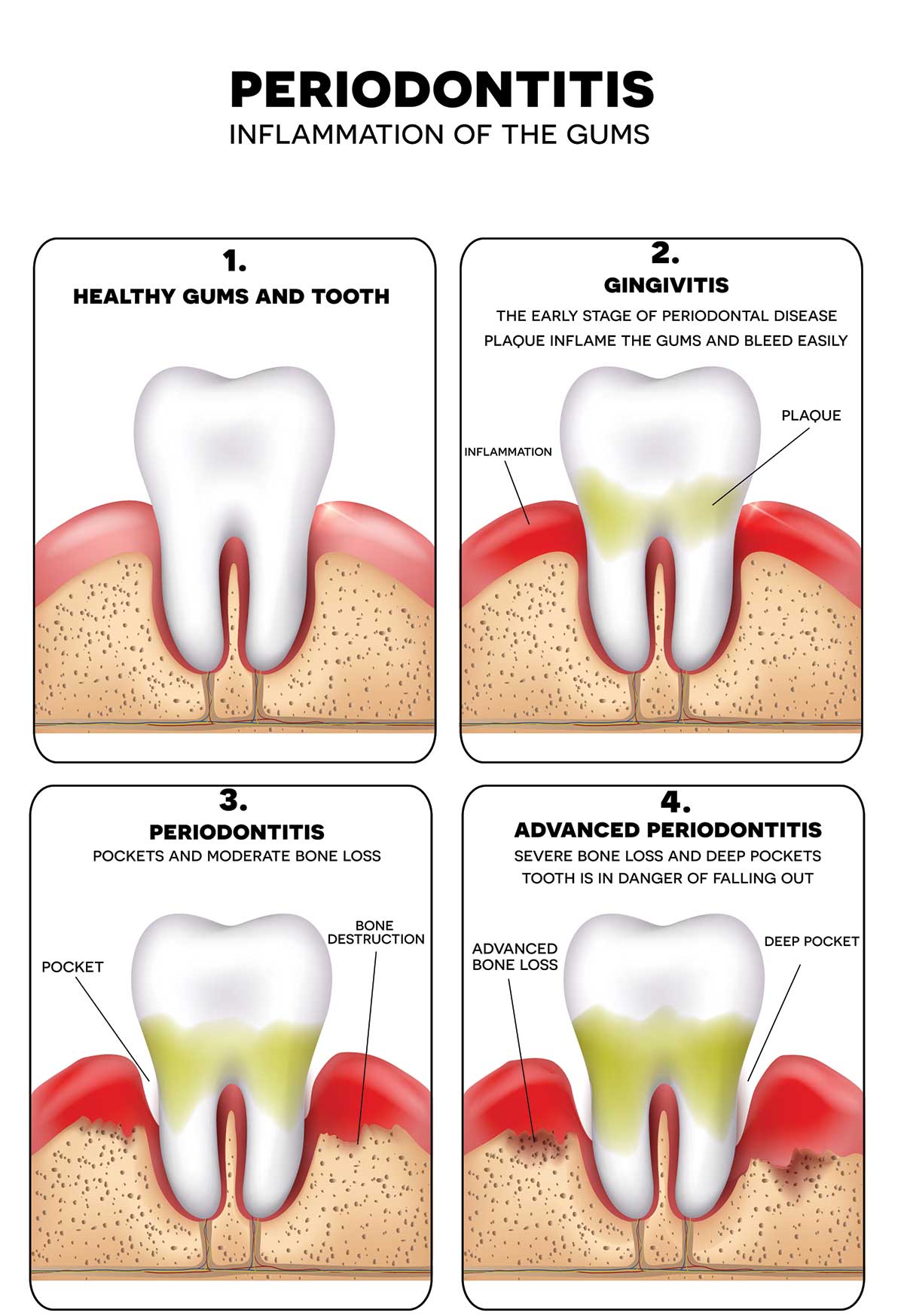
Gingivitis is usually the onset of gum disease. It is hallmarked by tender or swollen gums, light bleeding when flossing, bad breath, and/or a bright red colour. This form of gum disease affects the gingiva, which is the part of the gum that’s around your teeth. Because the infection has not settled below the surface of the gum line, gingivitis is easier and less expensive to treat.
The most common cause of gingivitis is poor oral hygiene. This is something that is completely within the control of the patient as long as you have the proper tools. Brushing your teeth twice a day, flossing every day, and getting regular dental check-ups are the best ways to treat or prevent gingivitis.

A more serious form of gum disease is periodontitis. This is considered more moderate or severe than gingivitis because the infection affects the gum and the jawbone. Symptoms of periodontitis include:
● Swollen, tender, or puffy gums
● Gums that bleed easily
● Tooth breakage or tooth loss
● Receding gum line
● New spaces or gaps in between teeth
● A change in the way your teeth fit together when you bite
● Pain while chewing
Similar to gingivitis, the cause of periodontitis is often linked directly to poor oral hygiene. Having gingivitis increases your risk of developing periodontitis, especially if gingivitis goes untreated. Brushing, flossing, and getting regular dental check-ups is essential in preventing periodontitis in the first place, as well as preventing the condition from becoming worse.

This is the final stage of gum disease and the patient’s teeth can usually not be saved at this stage. The fibers and bone supporting teeth are destroyed, which leads to loose teeth. A very uncomfortable situation where your bite gets affected. Our dentists will work with you to try to keep the teeth and you may need to see a gum specialist otherwise known as a periodontist. Failing which, teeth may need to be removed. Our dentists will be able to discuss the steps to use implants or dentures depending on the severity of your situation.




Your dentist will often discover signs of gum disease during your routine dental check-up. However, if you experience symptoms of gum disease in between visits, we encourage you to schedule an appointment for further investigation. Once we diagnose your condition, we can recommend the appropriate treatment options.

Every patient we work with is unique. We take into account your medical and dental history, your budget, and other factors that may impact our treatment recommendations. Rest assured we aim to give you the most effective gum disease treatment that will improve your chances of halting progression or eliminating the disease.
Treatments that we may explore include:
● Scaling
● Root planing
● Antibiotics
● Soft tissue grafts
● Bone grafts
● Flap surgery
● Tissue-stimulating enzymes
● Guided tissue regeneration
● Lifestyle changes

After we begin treatment, we will monitor your progress to ensure your gum disease symptoms are improving. This may take course over a single visit or multiple follow-up visits. Your dentist will keep you informed of your progress and provide estimates of when your treatment will be complete.
Keep in mind that there is no single magic cure for gum disease. Treatment is a journey and results are not immediate.
LATEST ARTICLES
What is Composite Fillings? and What is The Benefits?
White fillings are generally made from composite resin. Because of their colour, they blend in more naturally with the rest of your teeth. These days, almost all fillings are made from composite resin because they look better than their silver counterparts and they are less invasive.
4 simple dental tips whilst in Covid lockdown
Being in lockdown is an extremely difficult time for many Australians. We can’t see friends, go places, incomes may be affected and we’ve lost our freedom.
Further to this people are getting sick and who knows when it will end?
What’s important is that we still have the ability to look after our health as best we can. So the following are our simple tips for a healthy mouth during lockdown.
The Most Comfortable Dental Clean in Sydney!
Everyone knows that a regular, professional dental clean is essential for long-term dental health. But not everyone likes the sensation of a dental clean. At Sydney Road Dental Care, we offer the no-touch Airflow dental clean. It’s a whole new way to deep clean your teeth that we promise you will enjoy – rather than endure! Now that’s a great reason to smile!

